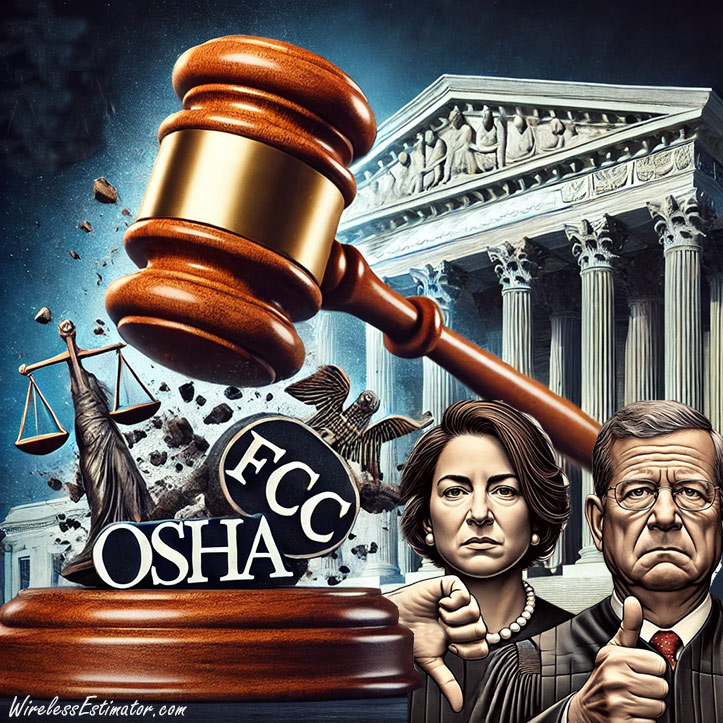
The U.S. Supreme Court tore apart four decades of regulatory law today in its Chevron deference decision, which puts regulatory rules interpretation in the hands of judges instead of experts. Chief Justice John Roberts said it was the court’s role to interpret statutory provisions. Justice Elena Kagan wanted to continue to have experts make those decisions.
On Friday, the U.S. Supreme Court dismantled decades of regulatory law, significantly complicating the ability of federal agencies like the FCC and OSHA to issue rules and regulations based on broad congressional mandates. This ideological ruling overturned a 40-year-old precedent that has guided how agencies interpret federal statutes.
The Supreme Court reversed the 1984 Chevron v. Natural Resources Defense Council decision. This precedent established that courts should defer to federal agencies’ reasonable interpretations when a statute is ambiguous. The unanimous 1984 ruling allowed agencies to use their expertise to fill legislative gaps, ensuring that broad congressional mandates were effectively implemented.
Chevron deference has been applied in cases where the FCC’s interpretation of the Communications Act was challenged. Courts have often upheld the FCC’s interpretations, recognizing the agency’s expertise in telecommunications law. This deference was crucial in decisions regarding net neutrality, where the FCC’s classification of broadband internet access under Title II of the Communications Act was supported by courts due to Chevron deference.
OSHA has interpreted Chevron deference in its enforcement actions. Courts have applied Chevron deference to OSHA’s interpretation of various statutory provisions. For example, the D.C. Circuit used Chevron deference in a case involving OSHA’s statute of limitations, supporting the agency’s interpretation. Similarly, the Fifth Circuit applied Chevron deference to OSHA’s interpretation regarding safety regulations affecting other employers’ employees.
The court’s new stance allows previous decisions to remain
In writing for the conservative majority, Chief Justice John Roberts asserted that Chevron “defies the command” of the law governing federal administrative agencies. He emphasized that it is the court’s role, not the agency’s, to interpret statutory provisions. Roberts clarified that prior cases relying on the Chevron framework remain valid under statutory decisions, despite the change in interpretive methodology.
Conservative push to abolish Chevron
Conservatives, including some current Supreme Court members, have long sought to abolish the Chevron decision. They argue that highly trained agency experts should not interpret ambiguous legislation, leaving such matters to the judiciary instead.
Drawing the line between legislative intent and agency interpretation can be challenging. For instance, is a new cholesterol-lowering product a dietary supplement or a drug? Justice Elena Kagan highlighted this difficulty, noting that Congress would prefer experts to make such decisions rather than judges unfamiliar with the issues.
Ripple effects and potential chaos
Justice Brett Kavanaugh noted that deferring to agency interpretations leads to significant policy changes with each new administration, creating instability. In dissent, the liberal justices argued that abandoning Chevron deference would hinder the government’s ability to address urgent problems and carry out congressional mandates effectively.
Justice Kagan wrote that Chevron has become integral to modern government, supporting efforts to keep air and water clean, food and drugs safe, and financial markets honest. Despite the Supreme Court’s infrequent reliance on Chevron in recent years, lower courts have made thousands of decisions based on this doctrine, making the ruling’s impact profound across the government.
Case background: fishery conservation law
The court’s decision stemmed from a fishery conservation law case, which required trained observers on fishing vessels. The issue was whether ship owners had to pay for these observers. Without explicit congressional authorization, the court ruled that the agency could not require fishermen to cover these costs.
Broader implications for Federal regulation
This ruling could hamper federal agencies’ regulatory capabilities, affecting pollution limits and consumer protections. Chevron deference allowed courts to lean on agency expertise for informed decisions. Overturning this doctrine shifts interpretive power to judges, potentially leading to inconsistency and confusion.
Historical context and political shifts
Chevron deference originated from the 1984 Chevron USA, Inc. v. Natural Resources Defense Council ruling. The decision allowed the industry-friendly EPA under President Reagan to adopt a more lenient interpretation of the Clean Air Act. Over time, Chevron deference has been politically agnostic but recently aligned with a deregulatory agenda.
In her dissent, Justice Kagan emphasized that Chevron deference has supported regulatory efforts across various sectors. Eliminating it invites judges to impose their policy preferences over those of political branches, undermining the doctrine’s original intent.
Due to two fishing industry cases, the Supreme Court took up Chevron deference this year. Plaintiffs argued that the National Marine Fisheries Service lacked authority to enforce payment for observers without explicit statutory language. Lower courts upheld the mandate using Chevron deference, but the Supreme Court overturned it.
Trade groups from diverse industries, including gun owners and e-cigarette companies, have pushed to limit Chevron deference. The decision also impacts net neutrality, with courts previously deferring to the FCC’s classification of broadband. The ruling risks bogging down courts with detailed regulatory questions previously handled by federal agencies.

















